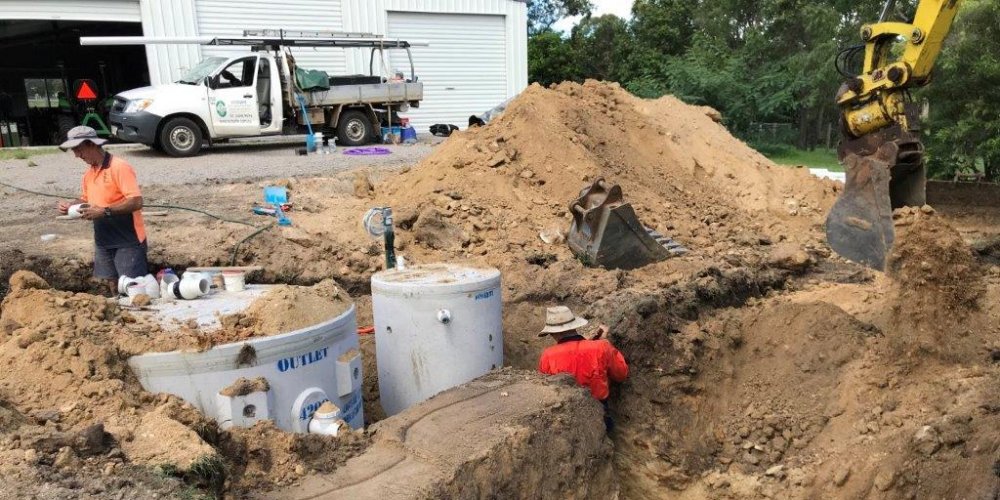To prepare your property for a new septic tank installation, start by evaluating your layout. Identify features like trees or slopes that may affect placement. Next, check local regulations to guarantee you have the right permits. Evaluate soil conditions with percolation tests to determine absorption capabilities. Map out existing utilities like water and gas lines to prevent disruptions. Also, plan for easy access to the tank for maintenance. Consulting with professionals can help you navigate these steps efficiently. There’s more to contemplate, so keep exploring to guarantee a smooth installation process.
Assess Your Property Layout
Before installing a new septic tank, you should carefully assess your property layout to guarantee proper placement and functionality. When considering the installation of septic tanks in Sunshine Coast, start by reviewing your property boundaries; knowing where your land begins and ends is vital to prevent encroachments and legal issues.
Identify any landscape features, such as trees, slopes, and drainage areas, that might affect the tank’s installation and performance.
You’ll want to ascertain the septic tank is placed away from trees, as their roots can interfere with the system.
Additionally, consider the proximity to your home and existing plumbing.
By keeping these factors in mind, you can make informed decisions that optimize your septic system’s efficiency and longevity.
Taking the time to assess now will save you headaches later.
Check Local Regulations
Checking local regulations is essential to assure your septic tank installation complies with all necessary laws and guidelines.
Before you begin, look into the septic tank permits required in your area. These permits assure that your installation meets local health and safety standards.
You’ll also want to familiarize yourself with the installation guidelines provided by your local health department or environmental agency. These guidelines often include specific requirements for tank size, distance from water sources, and maintenance protocols.
By understanding these regulations, you can avoid potential fines or costly delays in your installation process.
Always consult with professionals if you’re uncertain about any local rules, as they can guide you through the permitting and installation requirements effectively.
Evaluate Soil Conditions
Before installing your septic tank, you’ll need to assess the soil conditions on your property.
Understanding the soil type, conducting percolation tests, and reviewing drainage considerations are essential steps in ensuring a successful installation.
These factors can greatly impact the performance and longevity of your septic system.

Soil Type Assessment
Evaluating your soil type is essential, as it directly impacts the effectiveness and longevity of your new septic tank system.
Start by examining soil compaction, which affects how well wastewater can flow through the ground. If your soil is too compacted, it can hinder drainage and lead to system failures.
Next, assess the drainage patterns on your property. Observe how water moves during rainfall or irrigation; this will help you understand how your septic system will interact with the soil. If you notice poor drainage, you may need to amend the soil or consider an alternative system.
Taking these steps guarantees your septic tank installation will function efficiently and prevent future problems.
Percolation Testing Importance
Percolation testing is vital for determining how well your soil absorbs water, which directly influences the design and functionality of your septic system. By evaluating soil conditions, you can guarantee effective waste treatment.
Here are some key benefits of percolation testing:
- Identifies suitable percolation methods for your soil type.
- Determines the best location for your septic system installation.
- Informs you about testing frequency required for accurate results.
- Helps prevent costly repairs caused by improper system placement.
Conducting percolation tests before installation allows you to understand your land’s drainage capabilities, guaranteeing your septic system operates efficiently and effectively.
Don’t skip this vital step—your property deserves proper preparation!
Drainage Considerations Review
Understanding your soil’s drainage capabilities is vital to guaranteeing that your new septic tank functions properly and efficiently.
Start by evaluating the soil conditions on your property. Test for permeability to determine how quickly water drains, as this affects the septic system’s performance.
If your soil retains too much water, you might need to explore drainage solutions, such as installing drainage pipes or creating swales to redirect excess runoff.
Effective runoff management is essential to prevent flooding and make sure the septic tank operates at its best.
Identify Existing Utilities
Identifying existing utilities is essential to guarantee a safe and efficient septic tank installation. Before you begin, you’ll want to conduct thorough utility mapping and utility marking to avoid any accidents.
Here’s what to look for:
- Water lines – Verify you know where your main supply and any irrigation lines are located.
- Sewer lines – Identify existing sewer connections to prevent disruptions.
- Gas lines – Locate any gas utilities to avoid potential hazards.
- Electric lines – Know the position of electrical cables to safeguard against outages or shocks.
Plan for Accessibility
Once you’ve mapped out existing utilities, it’s important to plan for accessibility to guarantee a smooth installation process for your new septic tank.
Consider the septic tank placement carefully; it should be easily reachable for installation and future maintenance. Clear any obstacles, like trees or large rocks, that might hinder access. You’ll want to make sure that service vehicles can navigate to the tank without difficulty.
Additionally, think about the layout of your yard—avoid placing the tank too close to fences or other structures. This way, your maintenance access will remain convenient, allowing technicians to inspect and service the tank as needed without hassle.
Schedule Professional Consultations
When you’re ready to install your new septic tank, scheduling professional consultations is essential.
Experts can assess your site conditions, discuss local regulations, and evaluate the best system options for your needs.
This step guarantees that your installation meets all requirements and functions efficiently.
Assess Site Conditions
How do you determine if your site is suitable for a septic tank installation?
Start by evaluating site conditions that affect site drainage and the overall environmental impact. Here’s what to look for:
- Soil Type: Verify it’s suitable for absorption; sandy soils work best.
- Slope: A gentle slope helps with drainage and prevents overflow.
- Proximity to Water Sources: Keep your tank away from wells or streams to avoid contamination.
- Existing Structures: Check if there’s enough space between your tank and buildings or trees for maintenance.
Consulting professionals can provide valuable insights on these factors, confirming your site meets the necessary criteria for a successful septic tank installation.
Don’t overlook these essential evaluations!
Discuss Local Regulations
Understanding local regulations is vital to guaranteeing your septic tank installation complies with zoning laws and health codes.
Start by checking with your local health department or environmental agency to learn about septic tank permits required in your area. These permits often outline specific installation guidelines you must follow, including setback distances from property lines, water sources, and structures.
Schedule professional consultations with licensed contractors who are familiar with local regulations. They’ll help you navigate the permitting process and guarantee your installation meets all necessary standards.
Ignoring these regulations can lead to fines, delays, or even the need for costly reinstallation, so it’s vital to stay informed and compliant from the very beginning.
Evaluate System Options
Evaluating your septic system options requires scheduling consultations with experienced professionals who can guide you through the various choices tailored to your property’s needs.
During these consultations, you’ll discuss:
- System Types: Learn about conventional, alternative, and aerobic systems suited for your land.
- Installation Costs: Get estimates based on the chosen system type and local labor rates.
- Soil and Drainage Assessments: Understand how your soil conditions affect system performance.
- Maintenance Requirements: Discover what ongoing upkeep each system demands to guarantee longevity.


